Monthly Newsletter
April 2013
Springtime Maintenance Newsletter
Check Gutters and Downspouts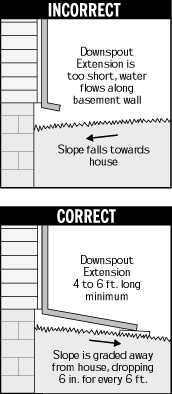 Newsletter: Gutters collect tremendous quantities of water from the roof and must deliver that water away from the foundation. Keep you downspouts extended at least 6 to 8 feet away from the foundation to a spot where the natural grade of the soil continues moving the water away.
Newsletter: Gutters collect tremendous quantities of water from the roof and must deliver that water away from the foundation. Keep you downspouts extended at least 6 to 8 feet away from the foundation to a spot where the natural grade of the soil continues moving the water away.If your area has underground storm sewers, make sure all downspouts are properly connected to the visible pipe fittings and that water flows into the storm sewer pipe during rainstorms. If this pipe backs up during a storm, it indicates that the storm sewer line is plugged or broken. Test the line by running a hose into the gutter. You can have this line cleaned by a sewer cleaner.
If dampness and seepage appear on basement walls near an underground storm sewer connection, a broken storm sewer line may be the cause. You can run water into the gutter during a dry spell; if moisture seeps into the basement, it indicates that the underground line is damaged. A sewer cleaner can evaluate and repair the line.
Keep gutters clean to prevent plugging and over-flowing of downspouts and storm sewer lines.
Gutters and Downspouts Newsletter
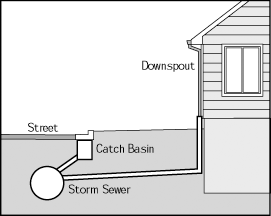 When it rains, your roof sheds a tremendous quantity of water that must be moved away from the foundation to protect the basement or crawl spaces. Gutters, downspouts and downspouts extensions serve this function.
When it rains, your roof sheds a tremendous quantity of water that must be moved away from the foundation to protect the basement or crawl spaces. Gutters, downspouts and downspouts extensions serve this function.Gutters may drain to the surface of your yard. They may be channeled underground to drain into the lower area of your yard. In urban areas, where storm systems collect rainwater; gutters may drain underground into the storm sewer system.
Newsletter Must Know/Must Do Roof, Gutters and Downspouts
- Inspect (or hire a professional to inspect) the roof and flashing twice a year.
Gutters must be cleaned and kept clear of debris. Som etimes twice a year is enough. At other times this must be done once a week, depending on the prevalence of leaves and other materials.
- Keep the drains of a flat roof clear of debris.
- Make sure all downspouts are directed away from the foundation.
- Downspouts routed underground must be cleared or repaired if they "back up."
- Check the roof for wear every few years. Plan for eventual replacement based on professional advice.
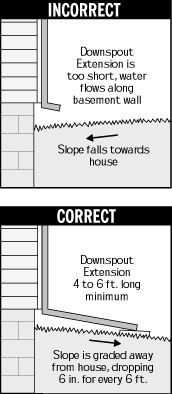 Proper grading around the house is your best protection against seepage into the basement that may cause expensive damage. (See figure on left) . When a home is built, workers dig the excavation several feet larger than the basement walls to allow for construction clearances. At the base of the hole, near the footing, they install a drain tile system and cover it with a small amount of gravel. After they apply a damp-proof coating to the wall, the hole is filled.
Proper grading around the house is your best protection against seepage into the basement that may cause expensive damage. (See figure on left) . When a home is built, workers dig the excavation several feet larger than the basement walls to allow for construction clearances. At the base of the hole, near the footing, they install a drain tile system and cover it with a small amount of gravel. After they apply a damp-proof coating to the wall, the hole is filled.Most of the hole around your basement is filled with soil from the site. This may contain gravel, rock, wood, paper, and unfortunately almost anything no longer useful for home construction. For the next 20 years, this soil and "stuff" settles around the basement walls. It settles quickly for the first few years and more slowly after that.
To divert surface water, the soil should pitch away from your home with a 1" pitch per linear foot for about 6 feet beyond the foundation. That is a 6" drop in 6 feet. You can measure this with a level and a straightedge held on top of the soil next to the foundation. At a minimum, the pitch should always have some slope for 6 feet beyond the foundation.
The soil should also be 6" below siding and wood trim to prevent water and insect damage. If wood siding touches the ground, water will wick up and rot the siding and framing. Also, the top course of block is less resistant to soil moisture because it probably lacks the moisture-proof coating applied to lower levels of the foundation wall.
To improve the grade, you have several options, depending on the landscape materials near your home.
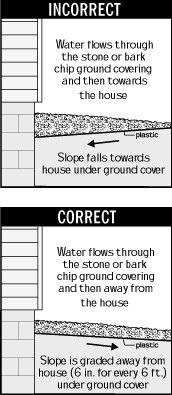 Bushes near the foundation, planted above the original foundation hole, often settle. If there is bare soil under the bushes, just add more soil. However, adding more than a few inches of soil can damage bushes by eliminating air from the roots. Check with a professional landscaper on the potential damage to your type of bushes. You may need to raise the bushes and fill under them.
Bushes near the foundation, planted above the original foundation hole, often settle. If there is bare soil under the bushes, just add more soil. However, adding more than a few inches of soil can damage bushes by eliminating air from the roots. Check with a professional landscaper on the potential damage to your type of bushes. You may need to raise the bushes and fill under them.If the area around the foundation has a planting bed or bushes with a ground cover, the soil under the ground cover must pitch away from the foundation. (See figure on right) . Dig through the ground cover in several areas to check the grade of the soil. To improve this situation, remove the ground cover and fill with soil. Then replace the ground cover.
You may wish to use a fabric weed barrier or black plastic over the soil. The weed barrier will stop weeds while allowing air and water movement - good for plants but not ideal for the basement.
Black plastic does the best job of deflecting water and protecting your basement, but it can be hard on plants. If you use black plastic, cut large holes in plants to improve access to moisture and air.
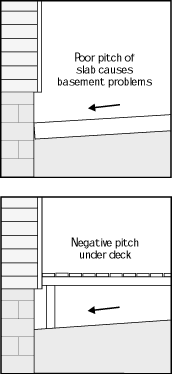 If there is sod next to the foundation, cut it with a sod cutter and fold it away from the foundation. Add soil, then lay the sod back in place. You could add soil directly over the sod, but that would require re-seeding, and the area will settle as the buried sod decomposes. Cover the sod only if it is in very poor condition or if you need a dramatic change in grade.
If there is sod next to the foundation, cut it with a sod cutter and fold it away from the foundation. Add soil, then lay the sod back in place. You could add soil directly over the sod, but that would require re-seeding, and the area will settle as the buried sod decomposes. Cover the sod only if it is in very poor condition or if you need a dramatic change in grade.For flower beds and bare soil, just add topsoil fill. When grading, don't use a light moss-type soil; it will settle too much and hold moisture. In areas where you will not be planting, you can use clay. In plating beds use a blended or brown planting soil or garden soil. This heavier mixture will not wash away into the yard.
Don't forget to grade areas under decks. You can use black plastic over the properly graded soil to deflect water and stop weeds. A thin cover of gravel or stone will hold down the plastic and make the area more attractive.
All hard surfaces as walks and driveways should also be pitched away from your foundation. The good news is that only a slight grade, as little as 1/4" per foot, is adequate for hard surfaces. (See figure on left).

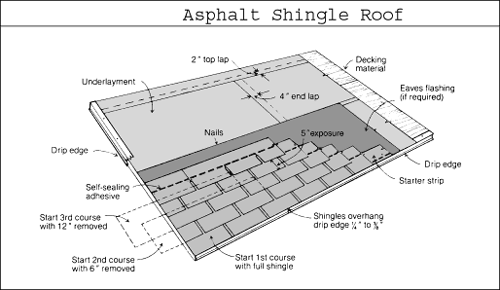
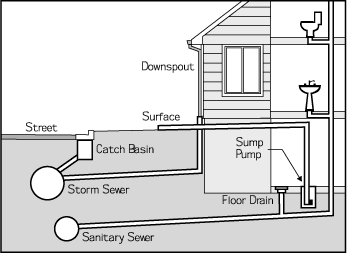
No comments:
Post a Comment
Thank You For Visiting us Whats on your mind?